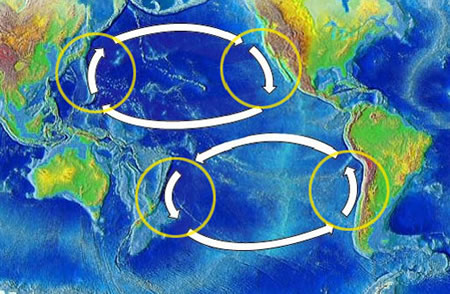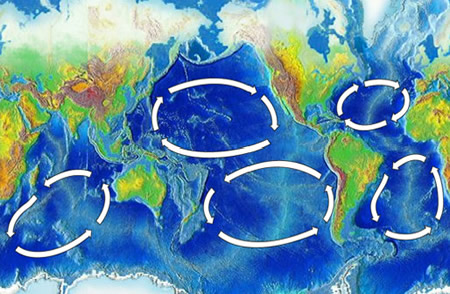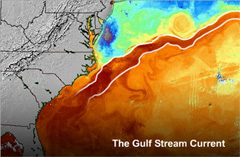Boundary Currents
Currents Tutorial
Global winds drag on the water’s surface, causing it to move and build up in the direction that the wind is blowing. And just as the Coriolis effect deflects winds to the right in the Northern Hemisphere and to the left in the Southern Hemisphere, it also results in the deflection of major surface ocean currents to the right in the Northern Hemisphere (in a clockwise spiral) and to the left in the Southern Hemisphere (in a counter-clockwise spiral). These major spirals of ocean-circling currents are called “gyres” and occur north and south of the equator. They do not occur at the equator, where the Coriolis effect is not present (Ross, 1995).


One particularly powerful western boundary current is the Gulf Stream. The Gulf Stream, paired with the eastern boundary Canary Current, flanks the North Atlantic gyre. The Gulf Stream, also called the North Atlantic Drift, originates in the Gulf of Mexico, exits through the Strait of Florida, and follows the eastern coastline of the United States and Newfoundland. It travels at speeds of 25 to 75 miles per day at about one to three knots (1.15-3.45 miles per hour or 1.85-5.55 kilometers per hour). It influences the climate of the east coast of Florida, keeping temperatures warmer in the winter and cooler than the other southeastern states in the summer. Since it also extends toward Europe, it warms western European countries as well.
Currents Lessons
- Welcome
- Tidal Currents 1
- Tidal Currents 2
- Waves
- Longshore Currents
- Rip Currents
- Upwelling
- The Coriolis Effect
- Surface Ocean Currents
- Boundary Currents
- The Ekman Spiral
- Thermohaline Circulation
- The Global Conveyor Belt
- Effects of Climate Change
- Age of Exploration
- What is a "knot"?
- Shallow Water Drifter
- Deep Ocean Drifter
- Current Profiler
- Shore-based Current Meters
- How Currents Affect Our Lives?
- References
- Roadmap to Resources
- Subject Review
